

Back to Our Egypt Trip
Abu Simbel was built on the Southern end of Ramesses' (c.1279-c.1213BC) kingdom. It was built, as a warning to the Nubians and others, that this is where Egypt begins. It was also built to try to win over those who would do harm to Egypt.
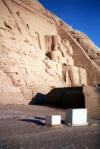 The
view, as we round the corner, at Abu Simbel. WOW!!
There are 4 -65 foot high statues of the deified Ramesses
II.
The
view, as we round the corner, at Abu Simbel. WOW!!
There are 4 -65 foot high statues of the deified Ramesses
II.
 The
smaller figures under Ramesses' feet, are his enemies, Nubians on the left, and
Hitittes and Libyans on the right. The figures, around his feet, are some of his
many children. At the very top of the East facing
facade, are baboons, heralding the rising sun.
The
smaller figures under Ramesses' feet, are his enemies, Nubians on the left, and
Hitittes and Libyans on the right. The figures, around his feet, are some of his
many children. At the very top of the East facing
facade, are baboons, heralding the rising sun.
 The upper portion of the second statue fell after a severe
earthquake, in the 31st year of Ramesses' reign. It was decided to leave it
where it fell, rather than restore it, when the site was moved.
The upper portion of the second statue fell after a severe
earthquake, in the 31st year of Ramesses' reign. It was decided to leave it
where it fell, rather than restore it, when the site was moved.
 Since tour guides are not allowed to give tours inside
many sites in Egypt (they tend to back up the large crowds), Amr instructs us on
what to look for when we enter the temple. He explains the panels with the
battle of Qadesh and what to look for on other various panels, and their
locations.
Since tour guides are not allowed to give tours inside
many sites in Egypt (they tend to back up the large crowds), Amr instructs us on
what to look for when we enter the temple. He explains the panels with the
battle of Qadesh and what to look for on other various panels, and their
locations.
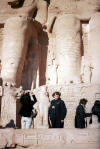
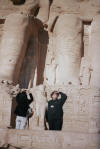 Marilyn, for scale. Notice the toes of Ramesses'
collossal statue above Marilyn's head.
Marilyn, for scale. Notice the toes of Ramesses'
collossal statue above Marilyn's head.

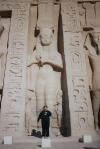 Larry's
favorite wife, Marilyn, as Nafertari.
Larry's
favorite wife, Marilyn, as Nafertari.
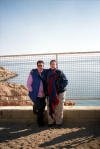 Our
friends, with Lake Nasser, in the background.
Our
friends, with Lake Nasser, in the background.
 The
Temple of Ramesses II, celebrates his worshipping the gods and his military
exploits.
The
Temple of Ramesses II, celebrates his worshipping the gods and his military
exploits.


 The
adjacent Temple of Horus and Nefertari (Ramesses' favorite wife).
The
adjacent Temple of Horus and Nefertari (Ramesses' favorite wife).
 It
was rather warm, for January, so we took a break under a scarce shade tree.
It
was rather warm, for January, so we took a break under a scarce shade tree.
 We're standing in front of the two temples. Ramesses' temples
is to the left and Nefertari's is to the right.
We're standing in front of the two temples. Ramesses' temples
is to the left and Nefertari's is to the right.
 The view from the back, showing the mountain constructed behind the colossal
statues at Abu Simbel.
The view from the back, showing the mountain constructed behind the colossal
statues at Abu Simbel.